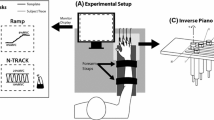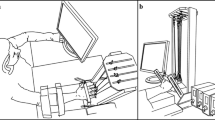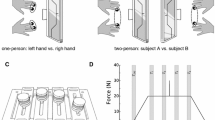Abstract.
We studied the coordinated action of fingers during static tasks involving exertion of force and torque on a handheld object. Subjects were asked to keep a handle with an attachment that allowed for independent change of the suspended load (0.5–2.0 kg) and external torque (0.375–1.5 N m) in a vertical position while applying minimal effort. Normal and shear forces were measured from the thumb; normal forces only were measured from the four fingers. Experimental results: (1) the thumb shear force increased during supination efforts and decreased during pronation efforts; (2) the total moment of the normal finger forces only counterbalanced approximately 50% of the external torque, hence shear forces accounted for approximately one-half of the total torque exerted on the object; (3) the total normal force increased with external torque, and the total force magnitude did not depend on the torque direction; (4) the forces of the `peripheral' (index and little) fingers depended mainly on the torque while the forces exerted by the `central' (middle and ring) fingers depended both on the load and torque; (5) there was a monotonic relationship between the mechanical advantage of a finger (i.e., its moment arm during torque production) and the force produced by that finger; and (6) antagonist finger moments acting opposite to the intended direction of the total moment were always observed – at low torques the antagonist moments were as high as 40–60% of the agonist moments. Modeling: A three-zone model of coordinated finger action is suggested. In the first zone of load/torque combinations, activation of antagonist fingers (i.e., fingers that generate antagonist moments) is necessary to prevent slipping. In the second zone, the activity of agonist fingers is sufficient for preventing slips. In the third zone, the performer has freedom to choose between either activating the antagonist fingers or redistributing activities amongst the agonist fingers. The findings of this study provide the foundation for neural network and optimization modeling described in the companion paper [Zatsiorsky et al. (2002) Biol Cybern DOI 10.1007/s00422-002-0320-7].
Similar content being viewed by others
Author information
Authors and Affiliations
Additional information
Received: 8 August 2001 / Accepted in revised form: 7 February 2002
Rights and permissions
About this article
Cite this article
Zatsiorsky, V., Gregory, R. & Latash, M. Force and torque production in static multifinger prehension: biomechanics and control. I. Biomechanics. Biol Cybern 87, 50–57 (2002). https://doi.org/10.1007/s00422-002-0321-6
Issue Date:
DOI: https://doi.org/10.1007/s00422-002-0321-6




